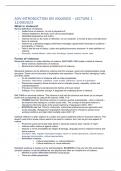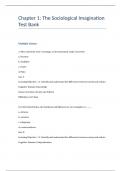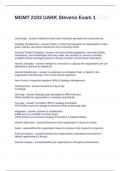AOV INTRODUCTION ON VIOLENCE – LECTURE 1
12/09/2023
What is violence?
Narrow definition of violence:
o Visible forms of violence: “an act of physical hurt”
o Violence targeted on the body, but it can be psychological
o Identifiable perpetrators and victims
o Violence we see on the news on television, on our computer, in movies & docu’s (mostly direct
forms of violence)
o Violence as a spectacle (staged, performed) messages; appall and/or fascinate an audience –
pornography of violence
o Fails to see the role of history, culture and political-economic structures wider definition of
violence.
o Examples: suicide attacks, urban riots, bombings, (mass) murders, torture, rape
Forms of violence
Structural violence is a wider definition of violence. GALTUNG (1969) made a model of violence:
o Direct violence (visible forms of violence)
o Structural and cultural violence (invisible forms of violence)
Structural violence can be defined as violence built into unequal, unjust and unrepresentative social
structures. These can be structures of exploitation and repression. They’re harmful, damaging, hurtful
and often violent.
o It’s an invisible form of violence with no clear perpetrator
o Examples: imperialism, capitalism, caste society, patriarchy, racism & colonization
o Phenomena caused by these structures are for example poverty, inequality, racism and
underdevelopment
o It focuses on history & (social)economic factors and local context
o Critique: it is a container concept, it disguises the underlying forms of violence
GALTUNG on structural violence “The violence is built into the structure and shows up as unequal
power and consequently as unequal life chances (1969, 171)”
o FARMER said that “Structural violence is violence exerted systematically – that is indirectly –
by everyone who belongs to a certain social order. The concept of structural violence is
intended to inform the study of the social machinery of oppression (2001, 307)”
o BOURGOIS said that “Chronic, historically, entrenched political-economic oppression and
social inequality. Ranging from exploitative international terms of trade to abusive local
working conditions and high infant mortality rates (2001, 8)”.
Cultural violence is when aspects of a culture are used to legitimize direct or structural violence. This
doesn’t mean that a whole culture needs to be used for violence, but it can be just one aspect of
culture.
o Prominent social norms that make direct or structural violence seen “natural’ of “right”
o Violence within culture of against culture
o Aspects or norms exemplified by religion & ideology, language and art, empirical science and
formal science
o Examples: hate, negative stereotype images, racism or sexist expressions, cultural erasure,
language discrimination, cultural appropriation.
o Normalizes violence
Cultural essentialism vs. cultural relativism
Cultural relativism vs. moral relativism
Symbolic violence is studied a lot by anthropologists. BOURDIEU is the one who first wrote about
symbolic violence. It can be defined as non-physical and often an invisible form of violence.
o Manifest in power differentiate between social groups
o There are visible perpetrators
, o Relations with domination and inequality
o Examples: power differences within gender relations or class relations
o With consent or complicity “it is violence which is exercised upon a social agent with his or her
complicity” (BOURDIEU & WACQUANT, 2004 273)
o Blaming those in lower power positions themselves for the violence they suffer from
o “The internalized humiliation and legitimation of inequality and hierarchy ranging from sexism
and racism to intimate expressions of class powers. It is exercised through cognition and
misrecognition, knowledge and sentiments, with unwitting consent of the dominated”
(BOURGOIS 2004, 426)
Everyday violence is a concept of NANCY SCHEPER-HUGHES.
o “Daily practices and expressions of violence on a micro-interactional level: interpersonal,
domestic and delinquent”
o It focuses on the individual experience that normalizes petty brutality and terror at the
community level and creates a common sense of ethos of violence.
o There are no sudden eruptions of violence, but it is part of the everyday; the routinized and
normalized
o It is visible or at least discernable
o Examples: domestic violence, gang violence, drug trafficking or shootings
Violence continuum means that violence is reproduced overtime, in chains, spirals and mirrors that
form a continuum of violence.
o Violence is analyzed: “along a continuum from direct physical assault to symbolic violence
and routinized everyday violence, including chronic, historically embedded structural violence
whose visibility is obscured by globalized hegemonies”
o Violence cannot be categorized: “it can be everything and nothing; legitimate or illegitimate;
visible or not visible; necessary or useless; senseless and gratuitous or utterly rational and
strategic”.
, AOV (POST)COLONIAL VIOLENCE – LECTURE 2
20/09/2023
What is colonialism/ imperialism?
Colonialism is the domination of a territory and its people by a foreign power with the aim of military,
economic, or other gain.
o Colonialism has existed since antiquity (Greek colonization)
When we speak of colonialism nowadays, we mainly focus on modern colonialism which is about the
western colonization of large parts of the world.
o Beginning in the 15th century: the Spanish and Portuguese conquests of Latin America
o Large-scale and long-lasting violence
Imperialism comes from the Latin word imperium for empire.
o It is an expansionist logic (like colonialism)
o Can be defined as the extension of power from an imperial center over foreign people
o Imperialism does not always entail control of foreign territory
Unlike colonialism
Example: Cultural imperialism
o Imperialism is the ideology/logic driving military colonial projects
A definition of colonialism by OSTERHAMMEL: “Colonialism is a relationship between an
indigenous (or forcibly imported) majority and a minority of foreign invaders. The fundamental
decisions affecting the lives of the colonized people are made and implemented by the colonial rulers
in pursuit of interests that are often defined in a distant metropolis. Rejecting cultural compromised
with the colonized population, the colonizers are convinced of their own superiority and their ordained
mandate to rule”
o It was first a religious superiority (Christianity) which legitimized the use of violence
o This changed to the race superiority which again legitimized the use of violence
Race
Race is a social construct. It is a difference which is seen as biologically inscribed and fixed. The
concept of race emerged during the colonial encounters. It enabled and legitimized trans-Atlantic slave
trade.
o Difference described as blood and later as genes it is socially constructed
o Race is used for legitimizing colonialism and violence
Racism and racial hierarchies:
o Proclamation of absolute difference
o Slavery implies complete dehumanization
Turning humans into objects
Slavery was extremely violent. Race was the ideology that allowed this
kind of violence. It proclaims the difference between people and creates a
hierarchy superiority and inferiority
o Racism provided the ideology to legitimize this
Ideas of biological evolution fueled ideas of racial hierarchies. And these racial categorizations were
(and are) used to establish social hierarchies.
o Social Darwinism: applying the Darwinist thought on evolution to human society
o Evolutionist thought
Anthropology played a key role in these racial categorizations. Early anthropologist studied
‘primitive’ people.
o Can be seen as the handmaiden of colonialism
o Involvement in colonial knowledge production and rule






